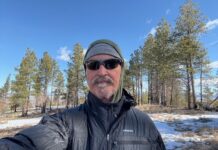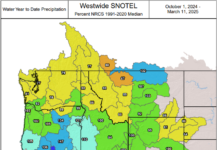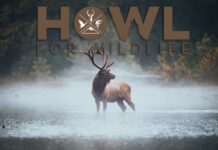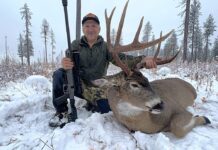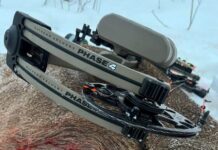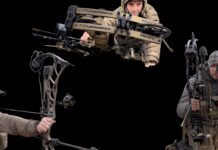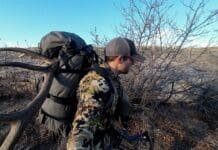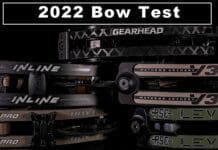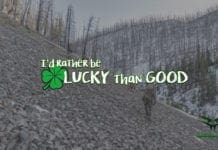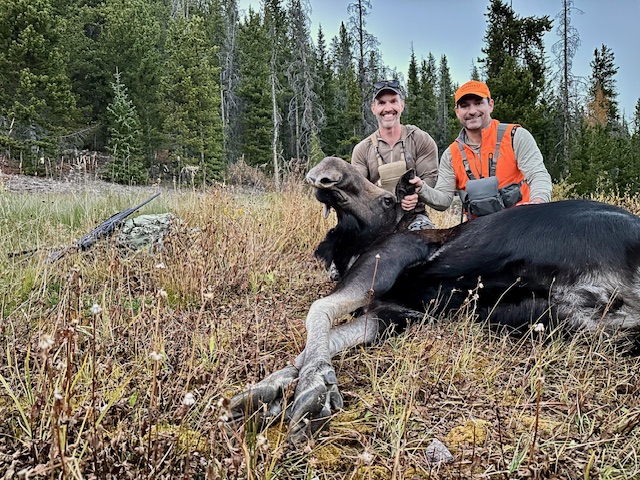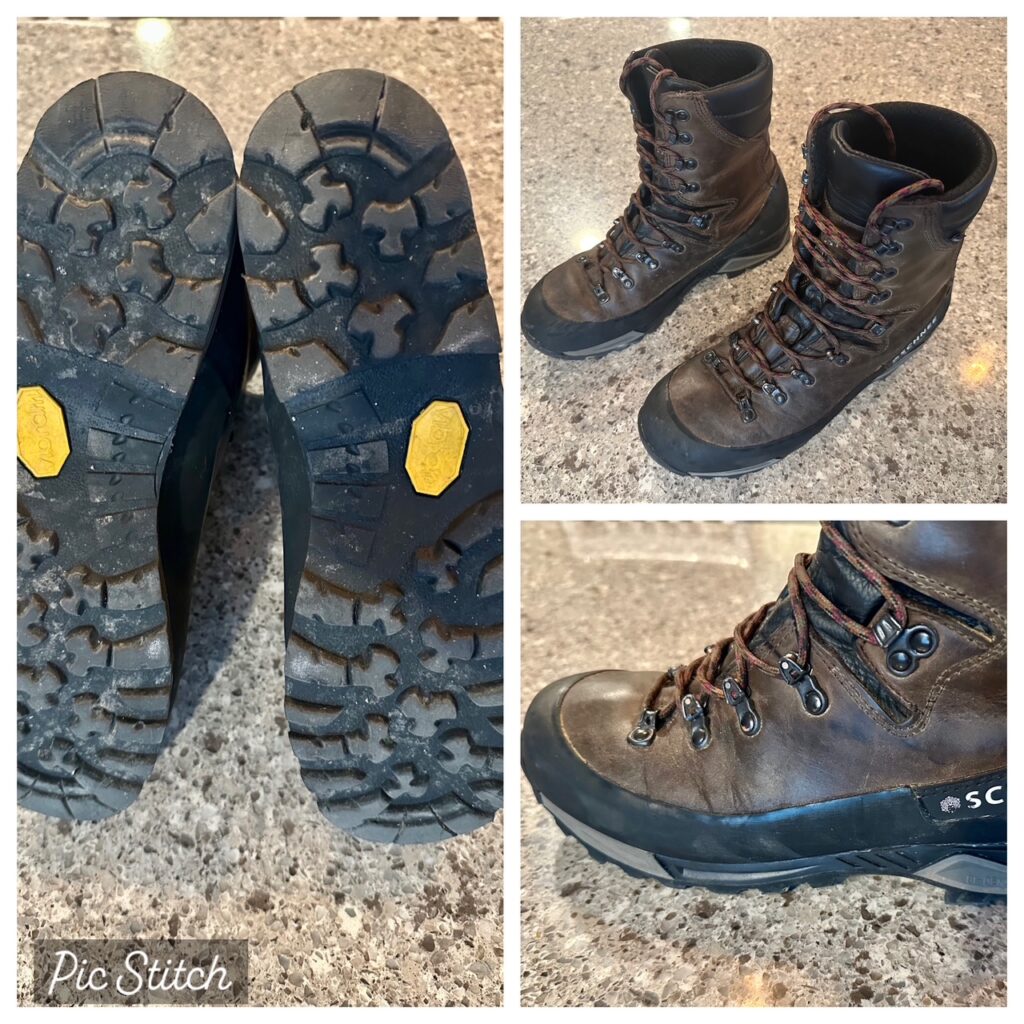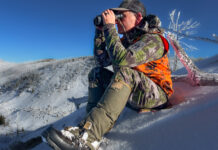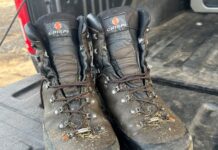Choosing Boots
Finding the ideal balance between weight, durability, waterproofing, comfort, and price can make selecting the perfect boot challenging. Boot fit and design are highly personal, much like choosing a scope, rifle, or caliber – what works well for one person may not necessarily suit another. For the past decade, I have relied on lightweight Gore-Tex hiking boots, including models from Vasque, Lowa, Crispi, and Salomon, averaging a pair per year. Luckily Salomon’s warranty has paid for multiple pairs of replacement boots.
However, as my collection of worn-out Salomon Quest 4D GTX boots began to outgrow the shelf they were stored on, I found that all of them were no longer waterproof and, in many cases, no longer suitable for anything but mowing the lawn. This prompted me to reevaluate whether my boot choice was truly aligned with my hunting needs.
I have always been hesitant to invest in high-end leather boots, largely due to their steep price, added weight, and lengthy break-in period. Yet, replacing my Salomon boots annually has become both costly and frustrating. By the time they fit my feet like a well-worn pair of hiking boots should, the rubber toe cap was often peeling, the soles cracked, and their waterproofing, if it had been effective at all, was long gone.

Schnee’s Beartooth V3
Rokslide provided me with the opportunity to test Schnee’s latest model, the Beartooth V3 boots with 0g of insulation. Schnees provided the boots with no strings attached–I could write about both the good and bad, like all Rokslide writers do. My initial impressions of these boots were that they differed greatly from my typical hunting boot. They were taller, heavier, and seemed more robust than what I typically wear. A unique feature is that these boots are rebuildable by Schnees, something that can offset the cost overtime. I was fortunate to have a busy fall season filled with various hunts, including a moose hunt with a friend, both a muzzleloader elk & pronghorn hunt, a late-season mule deer hunt, and multiple hunts for deer, elk, and pronghorn with my wife and daughter.
Muzzleloader Bull Elk
The Beartooth V3 boots arrived just a couple of days before my solo bull elk hunt, and with no opportunity to break them in beforehand, I decided to go for it, and see just how much of a break-in period these Beartooths truly needed. My plan was to hike into a basin and camp along a creek four miles from the truck, targeting bugling bulls above timberline.
With 52 pounds on my back, I made my way toward the creek where I intended to set up camp. During my preseason scouting, I found the elk were another 3-4 miles beyond the creek in the following drainage. However, I quickly realized that the elk had moved into the basin where I had planned to camp. As I made my way in, I encountered bugling bull after bugling bull. To keep from being detected, I ended up having to climb up and over a saddle, then side hilling through a scree field above the broken timber where the elk were rutting.
Initial Impressions
My initial impressions of the Beartooth V3 boots were largely positive, particularly regarding their weight. Although these boots are on the heavier side, I didn’t experience any noticeable penalty once they were on my feet. Weight had been one of my primary concerns, but I found that it wasn’t an issue during my hike. The second notable observation was boot stiffness and firmness of the footbed compared to my Salomons.
While side-hilling through the scree field, I began to feel tenderness on the outside of my downhill foot. The metatarsal bone near my pinky toe became painful enough that I decided to stop and inspect the boot. After removing it, I checked for any pressure points inside the boot and then swapped out my Darn Tough Midweight socks for Darn Tough Heavyweight socks, which I had brought as a backup. The thicker socks made an immediate difference, and I was able to push on to the only water source I could find which wasn’t overrun by rutting elk: a stinky elk wallow just above timberline on the back side of the basin.
Better After Break-In
After the initial tenderness, I never had any issues with foot discomfort regardless of sock thickness. I will also say that while I have never had ankle issues, the full height leather boot provided excellent ankle support while crossing scree fields and later in the year in snow covered rocks.

During this trip, as well as a few subsequent outings, that resulted in meat for the freezer and an opportunity at a bull of a lifetime, the Beartooth V3 boots repeatedly demonstrated their value. Whether navigating through boggy creek headwaters, walking across dew-covered meadows, or making frequent creek crossings, these boots consistently proved that Schnee’s waterproofing technology was highly effective, keeping my feet dry and comfortable throughout the hunts.
Antelope Muzzleloader Hunt
For my muzzleloader buck antelope hunt, I decided to forgo the Schnee’s and instead opted for my “best” pair of Salomon boots. Though the hunt lasted only a few hours, it required belly crawling through a cut field and then lying in the sun until the buck finally stood at 78 yards. In this situation, I was grateful for the lighter weight and agility offered by the Salomons.

During this hunt, I realized that a single boot for all conditions and endeavors was not the best option for me. The Schnee boots would have performed perfectly fine on this hunt, but having a lighter, softer-soled boot made for a quieter stalk and a more comfortable hunt due to the temperatures in the mid-80s.
Moose Hunt
I was invited to accompany a friend on a Colorado cow moose hunt, an opportunity I eagerly accepted, knowing that drawing a tag of my own could take decades. Over the course of three days, we traversed willow-choked meadows, often spending more time in standing water than on dry ground. The tall Beartooths, combined with my Outdoor Research Crocodile Gaiters, performed flawlessly. Being able to walk across creeks up to 8-10” deep, and sneak through boggy meadows without having to worry about where I stepped was something I was not used to with my previous boot of choice. If I wasn’t already sold on the Schnee Beartooth V3 boots after my elk hunt, the moose hunt solidified their worth. A tall, full-leather, fully waterproof boot proved to be invaluable, outweighing any concerns about weight or cost.
Late Season Hunts
My late-season deer hunt presented a new challenge for the Schnee Beartooth V3 boots: knee-deep snow and frigid temperatures. This hunt was another solo expedition in a unit I had never visited before. I arrived two days early to familiarize myself with the area and hopefully locate a mature buck. The fresh snow had the deer on the move, and I encountered plenty of does and smaller bucks, with a couple of large bucks on private land.
I spent a couple of days hiking ridges and glassing distant basins, and I soon realized the Beartooth V3 boots, with 0 grams of insulation, weren’t fully up to the task in these extreme conditions. My feet were cold, something I hadn’t experienced with my cloth Salomon boots. While I’ve owned insulated boots in the past, I typically found my Salomon Quest boots warm enough that insulation wasn’t necessary. Luckily, I brought air-activated toe warmers, which kept my feet warm for the remainder of the hunt.

Late Season Cow Elk
My daughter concluded our big game season with a late season cow elk hunt. With morning temperatures hovering around 0 degrees, I once again opted for the air activated toe warmers, and the boots performed flawlessly. She made a fantastic shot on a cow elk, and we used a sled to get the meat out. While crossing a “frozen” creek, my foot broke through the ice into the water below. Despite the water exceeding the height of the boots, the Schnee Beartooths, paired with my Outdoor Research Gaiters, kept my foot completely dry.

A Season Of Use
Over the course of four months, I logged 147 documented miles on 12 different hunts in the Schnee Beartooth V3 boots, with temperatures ranging from 0 degrees to 85 degrees and terrain that spanned dry prairies, boggy meadows, and knee-deep snow. While I encountered a few issues, such as initial foot soreness during the break-in period and cold feet while glassing in snowy conditions, the boots consistently proved their worth.
Conclusion
In the past decade, I’ve yet to own a pair of boots that have made it through an entire season without significant issues, always including a loss of waterproofing. The Beartooth V3, however, showed minimal signs of wear. The waterproofing remained intact, the Vibram soles still looked pretty good with small cracks forming at the toe flex point (shown below), and the leather, treated three times with Nikwax, was in excellent condition. I expect the Schnee Beartooth V3 boots to last for multiple years, and when the time comes, I plan to have them rebuilt at a fraction of the cost of replacing them. In the long term, I believe these boots will prove to be more economical than the significantly cheaper Salomons I was replacing annually.
SOLOMON QUEST 4D GTX 1 SEASON OF USE
SCHNEE BEARTOOTH V3 1 SEASON OF USE
Comment or ask Gian questions here.



